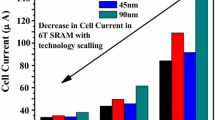Abstract
A decoupled inverter pair sense amplifier (DIPSA) is proposed for improved sensing in differential SRAM. The DIPSA is designed at 45-nm technology node with a decreased sensing delay of 31.44% and 28.44% over the conventional latch-type sense amplifier (CLSA) and current-latched SA with an NMOS footswitch (CSANF) at 1.1 V, respectively. The performance of DIPSA is validated using delay and power consumption comparison with prior SA designs across a set of supply voltages. Monte Carlo simulation for 3\(\sigma \) deviation yields a reliable design with no read failures and mean delay of 488.81 ps across the 1k data points with a deviation of 54.87 ps. The threshold voltage variation contribution to process variation is considered for these calculations. The sizing of the decoupling transistors is discussed and its impact on the delay and power of DIPSA shown. The performance of existing voltage and current sense amplifiers is compared to DIPSA.








Similar content being viewed by others
Data Availability
My manuscript has no associated data
References
Arizona State University NI, Group M (2008) Predictive Technology Models. http://ptm.asu.edu/latest.html
A.T. Do, Z.H. Kong, K.S. Yeo, Hybrid-mode SRAM sense amplifiers: new approach on transistor sizing. IEEE Trans. Circuits Syst. II Exp. Br. 55(10), 986–990 (2008)
A.T. Do, Z.H. Kong, K.S. Yeo et al., Design and sensitivity analysis of a new current-mode sense amplifier for low-power SRAM. IEEE Trans. Very Large Scale Integr. Syst. (VLSI) 19(2), 196–204 (2011)
D. Dutt, P. Mittal, B. Rawat et al., Design and performance analysis of high-performance low power voltage mode sense amplifier for static RAM. Adv. Electr. Electron. Eng. 20(3), 285–293 (2022)
C. Hernández, A. Roca, J. Flich et al., Characterizing the impact of process variation on 45 nm NoC-based CMPs. J. Parallel Distrib. Comput. 71(5), 651–663 (2011)
W. Marble, K. Kotani, C. Petrie, Practical charge-transfer amplifier design architectures for low-power flash A/D converters. IEEE Trans. Circuits Syst. I Regul. Pap. 51(11), 2157–2164 (2004)
J.K. Mishra, B.B. Upadhyay, P.K. Misra et al., Design and analysis of SRAM cell using body bias controller for low power applications. Circuits Syst. Signal Process. 40(5), 2135–2158 (2021)
P. Mittal, B. Rawat, N. Kumar, Tetra-variate scrutiny of diverse multiplexer techniques for designing a barrel shifter for low power digital circuits. Microprocess. Microsyst. 90, 104491 (2022)
M. Moghaddam, S. Timarchi, M.H. Moaiyeri et al., An ultra-low-power 9T SRAM cell based on threshold voltage techniques. Circuits, Syst., Signal Process. 35, 1437–1455 (2016)
S. Pandey, S. Kumar, V. Bhatnagar et al., A low leakage substrate bias-assisted technique for low voltage dual bit-line SRAM. Comput. Electr. Eng. 102, 108216 (2022)
D. Patel, A. Neale, D. Wright et al., Hybrid latch-type offset tolerant sense amplifier for low-voltage SRAMs. IEEE Trans. Circuits Syst. I: Regul. Pap. 66(7), 2519–2532 (2019)
D. Patel, A. Neale, D. Wright et al., Body biased sense amplifier with auto-offset mitigation for low-voltage SRAMs. IEEE Trans. Circuits Syst. I Regul. Pap. 68(8), 3265–3278 (2021)
B. Rawat, P. Mittal, A 32 nm single-ended single-port 7T static random access memory for low power utilization. Semicond. Sci. Technol. 36(9), 095006 (2021)
B. Rawat, P. Mittal, A comprehensive analysis of different 7T SRAM topologies to design a 1R1W bit interleaving enabled and half select free cell for 32 nm technology node. in Proceedings of the Royal Society A: Mathematical, Physical and Engineering Sciences 478(2259), 20210745 (2022)
B. Rawat, P. Mittal, A reliable and temperature variation tolerant 7T SRAM cell with single bitline configuration for low voltage application. Circuits Syst. Signal Process. 41(5), 2779–2801 (2022)
B. Rawat, P. Mittal, A switching NMOS based single ended sense amplifier for high density SRAM applications. ACM Trans. Des. Autom. Electron. Syst. 28(3), 1–14 (2023)
D. Schinkel, E. Mensink, E. Klumperink et al., A double-tail latch-type voltage sense amplifier with 18ps setup+ hold time, in 2007 IEEE international solid-state circuits conference. (Digest of technical papers, IEEE, 2007), pp. 314–605
E. Seevinck, P.J. van Beers, H. Ontrop, Current-mode techniques for high-speed VLSI circuits with application to current sense amplifier for CMOS SRAM’s. IEEE J. Solid-State Circuits 26(4), 525–536 (1991)
V. Sharma, S. Cosemans, M. Ashouei et al., A 4.4 pJ/access 80 MHz, 128 kbit variability resilient SRAM with multi-sized sense amplifier redundancy. IEEE J. Solid-State Circuits 46(10), 2416–2430 (2011)
N. Verma, A.P. Chandrakasan, A 65nm 8T sub-Vt SRAM employing sense-amplifier redundancy, in 2007 IEEE International Solid-State Circuits Conference. (Digest of Technical Papers, IEEE, 2007), pp. 328–606
B. Wicht, T. Nirschl, D. Schmitt-Landsiedel, Yield and speed optimization of a latch-type voltage sense amplifier. IEEE J. Solid-State Circuits 39(7), 1148–1158 (2004)
M. Wieckowski, S. Patil, M. Margala, Portless SRAM-A high-performance alternative to the 6T methodology. IEEE J. Solid-State Circuits 42(11), 2600–2610 (2007)
Y. Zhao, J. Wang, Z. Tong et al., An offset cancellation technique for SRAM sense amplifier based on relation of the delay and offset. Microelectron. J. 128, 105578 (2022)
J. Zhu, N. Bai, J. Wu, A review of sense amplifiers for static random access memory. IETE Tech. Rev. 30(1), 72–81 (2013)
Funding
Not applicable
Author information
Authors and Affiliations
Corresponding author
Ethics declarations
Conflict of interest
Not applicable
Code Availability
Not applicable
Additional information
Publisher's Note
Springer Nature remains neutral with regard to jurisdictional claims in published maps and institutional affiliations.
Rights and permissions
Springer Nature or its licensor (e.g. a society or other partner) holds exclusive rights to this article under a publishing agreement with the author(s) or other rightsholder(s); author self-archiving of the accepted manuscript version of this article is solely governed by the terms of such publishing agreement and applicable law.
About this article
Cite this article
Dahiya, A., Mittal, P. & Rohilla, R. Variation-Tolerant Sense Amplifier Using Decoupling Transistors for Enhanced SRAM Read Performance. Circuits Syst Signal Process 42, 5799–5810 (2023). https://doi.org/10.1007/s00034-023-02397-0
Received:
Revised:
Accepted:
Published:
Issue Date:
DOI: https://doi.org/10.1007/s00034-023-02397-0




